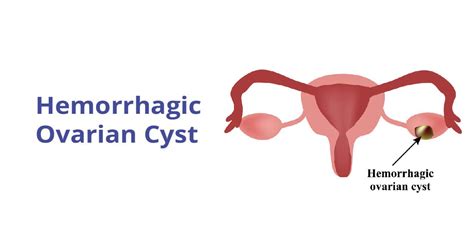Hemorrhagic ovarian cysts, a type of ovarian cyst that can cause significant distress and health complications in women, are characterized by the rupture of a cyst on the ovary, leading to internal bleeding. These cysts are usually filled with fluid but can also contain blood. Understanding the symptoms of hemorrhagic ovarian cysts is crucial for early detection and treatment, which can significantly improve outcomes and reduce the risk of severe complications. The symptoms can vary widely among women and may include:
Sudden, Severe Abdominal Pain: One of the most common symptoms of a hemorrhagic ovarian cyst is sudden and severe abdominal pain. This pain is often localized to one side of the abdomen, corresponding to the location of the cyst. The intensity of the pain can range from mild to severe and is typically sharp or stabbing.
Vomiting and Nausea: Accompanying the abdominal pain, nausea and vomiting are frequent symptoms. These can be triggered by the body’s reaction to the internal bleeding and the disruption of normal bodily functions.
Dizziness or Fainting: Due to the potential for significant blood loss, women with hemorrhagic ovarian cysts might experience dizziness or even faint. This occurs because the body may not be able to compensate for the loss of blood volume, leading to a reduction in blood pressure.
Shoulder Pain: Referred pain, which occurs when pain is perceived at a location other than the site of the painful stimulus, can sometimes be felt in the shoulder. This type of pain is usually due to the irritation of the diaphragm by blood in the abdominal cavity, which can stimulate nerve endings that also innervate the shoulder.
Heavy or Irregular Menstrual Bleeding: Although not universally present, some women with hemorrhagic ovarian cysts may experience changes in their menstrual cycle, including heavy or irregular bleeding. This is more common if the cyst affects hormonal balance or leads to complications that involve other reproductive organs.
Bloating and Swelling: The presence of a large cyst or significant internal bleeding can cause the abdomen to appear bloated or swollen. This can also be accompanied by discomfort or a feeling of pressure in the pelvic area.
Fever: In some cases, especially if there is an infection or if the cyst ruptures and leads to peritonitis (inflammation of the lining of the abdominal cavity), a fever may develop. This is a sign of the body’s immune response to the infection.
Changes in Urination Patterns: Large cysts can press on the bladder or ureters, leading to changes in urination patterns. Women may experience a frequent need to urinate or may have difficulty emptying the bladder.
Pain During Intercourse: The presence of a hemorrhagic ovarian cyst can cause pain during sexual intercourse due to the pressure and irritation of the surrounding tissues.
Increased Abdominal Pressure: Women may feel an increased sense of pressure or a feeling of being “bloated” in the abdominal area. This can be due to the size of the cyst or the accumulation of fluid or blood.
Palpable Mass: In some cases, especially if the cyst is large, it may be possible to feel a mass or lump in the abdomen. This should always be evaluated by a healthcare professional.
Missed Periods or Other Changes in Menstrual Cycle: While not specific to hemorrhagic ovarian cysts, any significant disruption in menstrual cycles, such as missed periods, should be investigated further, as it can be related to a variety of gynecological issues, including ovarian cysts.
It is essential to seek immediate medical attention if severe symptoms are experienced, as prompt treatment can significantly improve outcomes. Diagnosis typically involves a combination of physical examination, ultrasound, and sometimes other imaging tests like CT scans. Treatment options can range from watchful waiting for small, unruptured cysts to surgical intervention for larger cysts or those that have ruptured and are causing significant symptoms or complications.
For women experiencing symptoms that could indicate a hemorrhagic ovarian cyst, it is vital to remember that each individual’s experience can vary. Consulting a healthcare provider for personalized advice and care is essential.
Steps to Take if You Suspect a Hemorrhagic Ovarian Cyst:
- Contact your healthcare provider immediately if you experience severe abdominal pain, sudden onset of symptoms, or if you suspect you are at risk for a hemorrhagic ovarian cyst.
- Receive a thorough medical evaluation, including a physical exam and imaging studies as indicated.
- Follow your healthcare provider's advice regarding treatment options, which may include watchful waiting, medication, or surgery.
- Stay informed about your condition and the rationale behind your treatment plan to ensure the best possible outcome.
What are the chances of a hemorrhagic ovarian cyst rupturing?
+The risk of rupture varies and depends on several factors, including the size of the cyst and the presence of other symptoms. It's crucial to follow your healthcare provider's recommendations for monitoring and treatment to minimize this risk.
Can hemorrhagic ovarian cysts be prevented?
+While some risk factors for developing ovarian cysts cannot be changed, maintaining a healthy lifestyle, managing stress, and following regular gynecological check-ups can help in early detection and management of any issues that may arise.
What is the typical recovery time after treatment for a hemorrhagic ovarian cyst?
+The recovery time can vary significantly depending on the treatment method (surgery, watchful waiting, etc.) and the individual's overall health. Generally, surgical recovery can take several weeks, but it's essential to follow your healthcare provider's specific instructions for the best outcome.
Understanding the complexities of hemorrhagic ovarian cysts, recognizing the symptoms, and seeking timely medical intervention are critical steps in managing this condition effectively. By being informed and proactive, women can take control of their health and ensure the best possible outcomes.


